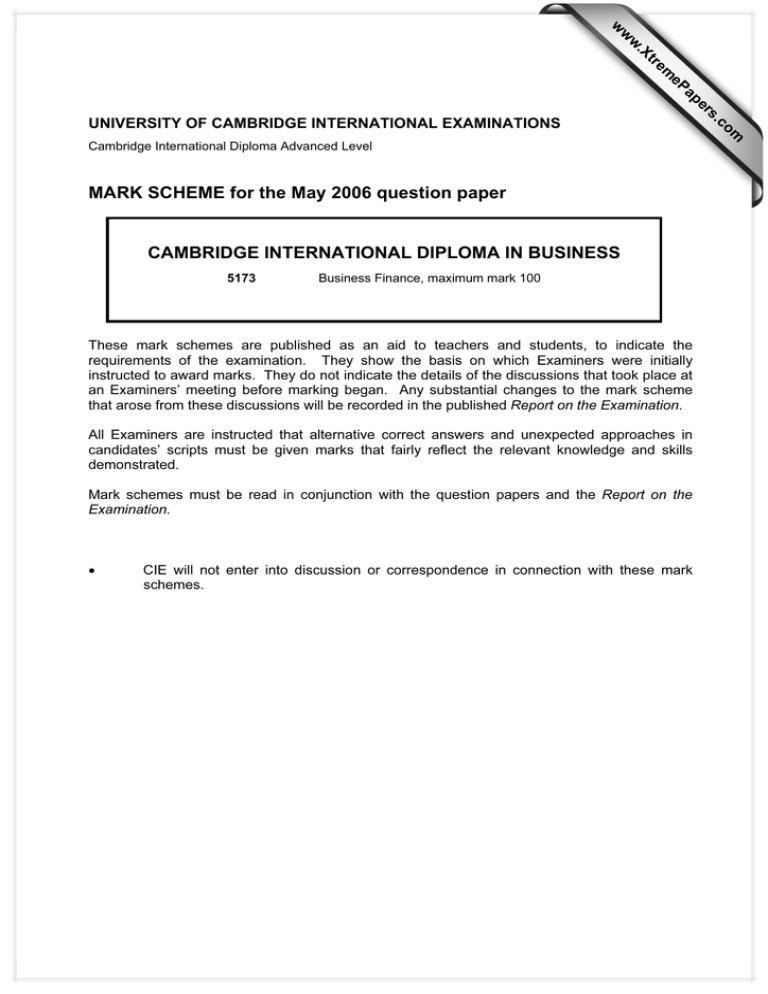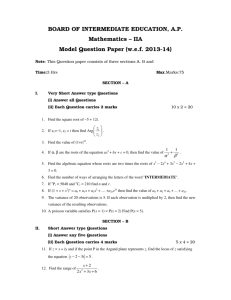MARK SCHEME for the May 2006 question paper www.XtremePapers.com
advertisement

w w ap eP m e tr .X w MARK SCHEME for the May 2006 question paper CAMBRIDGE INTERNATIONAL DIPLOMA IN BUSINESS 5173 Business Finance, maximum mark 100 These mark schemes are published as an aid to teachers and students, to indicate the requirements of the examination. They show the basis on which Examiners were initially instructed to award marks. They do not indicate the details of the discussions that took place at an Examiners’ meeting before marking began. Any substantial changes to the mark scheme that arose from these discussions will be recorded in the published Report on the Examination. All Examiners are instructed that alternative correct answers and unexpected approaches in candidates’ scripts must be given marks that fairly reflect the relevant knowledge and skills demonstrated. Mark schemes must be read in conjunction with the question papers and the Report on the Examination. • CIE will not enter into discussion or correspondence in connection with these mark schemes. om .c Cambridge International Diploma Advanced Level s er UNIVERSITY OF CAMBRIDGE INTERNATIONAL EXAMINATIONS Page 2 Mark Scheme Cambridge International Diploma – May 2006 Syllabus 5173 (8923) You must attempt ALL of the following tasks. 1 (a) Explain what is meant by the term multinational company. [3] A large company, international reputation, owns and operates in more than one country, employs nationals at senior levels. Allow 1 mark per characteristic to a maximum of 3 marks. (b) (i) Explain what is meant by ‘going public’. [2] Changing the form of an existing privately owned business by offering shares to the general public – floating the business on the stock market. Allow 2 marks if the explanation is complete. (ii) Identify and explain two methods that GSK might have used to ‘go public’. [4] Prospectus, placing, offer for sale, offer for sale by tender. For each method allow 1 mark for listing and a further mark for explanation. (c) (i) Identify two PEST factors that Narinder might take into account when preparing her report. [2] Allow 1 mark for each PEST factor identified. (ii) Explain how the PEST factors identified in (i) above might have an impact on GSK plc. [6] Allow up to 3 marks for a complete explanation as to how the factor may affect the operation of the firm. To achieve a full award the explanation should consider the likely effects on the level of sales/costs/profits etc. (d) Explain how Narinder’s work as a management accountant would differ from the work of a financial accountant. [3] Management accounting – concerned with providing reports/analysis for decision making purposes, interpretation of data, continuous process, budgeting/planning etc. Allow 1 mark per characteristic mentioned. Allow 1 mark if characteristic of financial accounting is given – e.g. maintaining records, producing statements. [Total for Question 1: 20] © University of Cambridge International Examinations 2006 Page 3 2 Mark Scheme Cambridge International Diploma – May 2006 Syllabus 5173 (8923) (a) Using the information in the case study, identify and calculate four relevant ratios that Narinder could use in her report to GSK plc. [4 x 4 = 16] Allow 1 mark for listing a relevant ratio. Allow 1 mark for stating the formula for the ratio. Allow 1 mark for extracting the relevant data for the ratio. Allow 1 mark for correct calculation of the ratio. Maximum of 4 marks for each ratio. (b) Identify and explain two limitations of using ratio analysis. [4] Allow 2 marks for each limitation listed and explained. Incorrect/estimated information, difficult to make comparison due to changes in methods etc. [Total for Question 2: 20] 3 (a) Identify four potential sources of funds that GSK plc could employ for its expansion programme. [4] Allow 1 mark per source listed. (b) For each of the sources identified in (a) above, give one advantage and one disadvantage of using that source of funding. [8] Allow up to 2 marks for each advantage/disadvantage if the explanation is relevant. (c) State, with reasons, which source of funding you would recommend that GSK plc should employ for its expansion programme. [8] Candidates need to demonstrate the ability to make effective comparison of the funding methods to achieve a full award for this task. The choice should be logical and must be supported by sound reasons. Level 1 – (1-4marks) Relevant choice has been made but not supported by relevant reason or only one reason offered. Level 2 – (5-8marks) Choice is supported by well argued reasons and choice is logical. [Total for Question 3: 20] © University of Cambridge International Examinations 2006 Page 4 4 Mark Scheme Cambridge International Diploma – May 2006 Syllabus 5173 (8923) (a) Explain why a firm such as GSK plc should depreciate its fixed assets. [6] Allow up to 2 marks for a well explained reason for implementing depreciation methods. To allow for wear and tear, to replace obsolete assets, to present a true and fair view, to make use of tax breaks. (b) Using the information in the case study, Item B, calculate: (i) the annual depreciation allowance that should be applied to the new fixed assets [4] (ii) the book value of the fixed assets at the end of year 6. [4] Allow 2 marks for providing the formula for calculating depreciation. Allow 2 marks for calculating the annual depreciation allowance. Allow 4 marks for calculating the book value at the end of year 6. (OFR rule applies for this calculation). For suggested solution see Appendix 1. (c) If GSK plc was to change to the reducing balance method of depreciation, explain what would be the likely effect upon the annual depreciation allowances and the effect upon the book value at the end of year 8. [6] Candidates are required to demonstrate that they appreciate how the two methods differ and operate. Allow up to 4 marks for a description of the reducing balance method as determining depreciation allowances by a fixed percentage – leading to higher initial allowances and smaller allowances towards the end. Allow a further 2 marks for an explanation that shows that both methods will lead to the same end result. [Total for Question 4: 20] © University of Cambridge International Examinations 2006 Page 5 5 Mark Scheme Cambridge International Diploma – May 2006 Syllabus 5173 (8923) Using the information in the case study, Item C, calculate: (a) the direct material price variance [4] Allow 2 marks for producing a relevant formula and a further 2 marks for a correct calculation. (b) the direct material usage variance [4] Allow 2 marks for producing a relevant formula and a further 2 marks for a correct calculation. (c) the direct material total variance [2] Allow 1 mark for producing a relevant formula and a further 1 mark for a correct calculation. (d) the direct labour rate variance [4] Allow 2 marks for producing a relevant formula and a further 2 marks for a correct calculation. (e) the direct labour efficiency variance [4] Allow 2 marks for producing a relevant formula and a further 2 marks for a correct calculation. (f) the direct labour total variance. [2] Allow 1 mark for producing a relevant formula and a further 1 mark for a correct calculation. For suggested solution see Appendix 2. [Total for Question 5: 20] © University of Cambridge International Examinations 2006 Page 6 Mark Scheme Cambridge International Diploma – May 2006 Syllabus 5173 (8923) Appendix 1 Annual Depreciation Allowance = = Initial Purchase Price − Residual Value Useful Life $2 500 000 − 300 00 8 = $275 000 Book value = Purchase Price – Accumulated Depreciation = $2 500 000 – (275 000 x 6) = $2 500 000 – 1 650 000 = $850 000 Appendix 2 (a) Direct material price variance 23 400 Kgs of raw materials should have cost (@ $15) Actual Cost Price Variance $351 000 $338 000 $13 000 (F) F = Favourable (b) Direct material usage variance 1000 units produced should have used 20 000 Kgs of materials (1000 x 20 kgs) = 20 000 kgs Actual Usage = 23 400 kgs Usage variance in Kgs 3 400 kgs X standard cost @ $15 = $51,000 (A) A = Adverse (c) Direct material total variance = Direct material price variance + material usage variance = $13 000 (F) + $51 000 (A) = $38 000 (A) (d) Direct Labour rate variance Difference between what 2900 hours should have cost and what it actually cost 2900 hours should have cost @ $ 8 hour = $23 200 Actual cost $24 000 Direct Labour rate variance $ 800 (A) (e) Direct labour efficiency variance 1000 units should have taken @ 3hrs per unit Actual hours Efficiency variance in hours X standard rate per hour @ $8 = 3000 hrs 2900 100 (F) $ 800 (F) (f) Direct labour total variance = Direct labour rate variance + direct labour efficiency variance = $800 (A) + $800 (F) = $0-no overall variance © University of Cambridge International Examinations 2006





